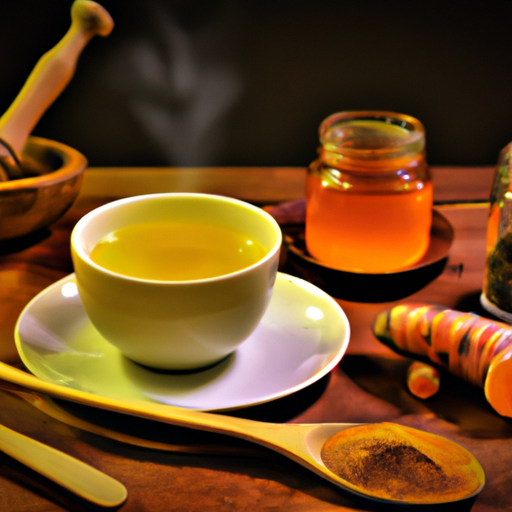I’ve been hearing a lot about the health benefits of turmeric, so I made a decision to start including it in my daily routine. I discovered that one of the most effective and simple ways to consume turmeric is by preparing turmeric tea. Yet, I didn’t have a clue about how to make it.
So, I did some research and experimented in the kitchen until I found my perfect recipe. Turmeric tea is a popular beverage in many parts of the world, known for its anti-inflammatory and antioxidant properties. It is believed to help with a variety of health conditions, including arthritis, digestive issues, and even depression.
Making turmeric tea at home is simple and quick, and it’s a great way to reap the many benefits of this powerful spice. In this article, I’ll share with you my recipe for making the perfect cup of turmeric tea, along with some tips for storage and the health benefits of this delicious beverage.
Key Takeaways
- Turmeric tea is popular for its anti-inflammatory and antioxidant properties, and is known to help with arthritis, digestive issues, and depression.
- To make turmeric tea, you will need fresh turmeric root or ground turmeric, fresh ginger root, honey or lemon (optional), black pepper (optional), and water. Brew by filling a tea kettle with water and boiling, adding turmeric, ginger, and black pepper to a tea infuser or bag, steeping for 5-10 minutes, straining, and pouring into a mug.
- Turmeric has potential health benefits, such as improved brain function and reduced risk of heart disease. It is best absorbed with black pepper or a source of fat, and has a positive impact on the immune system, gut inflammation, and bile production.
- Precautions and possible side effects include nausea, diarrhea, and stomach upset at high doses, and it may interact with blood thinners and lower blood sugar levels. Pregnant women should avoid large amounts and it is important to consult a healthcare provider before adding it to your daily routine.
Gather Your Ingredients
So, you’re ready to make some delicious turmeric tea – the first step is to gather all your ingredients! Preparation steps are essential to ensure that you have everything you need to make the perfect cup of tea.
Here are some ingredients you’ll need:
- Fresh turmeric root or ground turmeric
- Fresh ginger root
- Honey or lemon (optional)
- Black pepper (optional)
- Water
Ingredient variations can depend on your taste preferences or what’s available to you. Some people like to use cinnamon or cardamom to add more flavor to their turmeric tea. Others prefer to use coconut milk instead of water to make a creamy and delicious turmeric latte. The possibilities are endless!
Now that you have all your ingredients, it’s time to brew your tea.
Brew Your Tea
First, grab a tea kettle and fill it with water. Then, place it on the stove to boil while you prepare the rest of your ingredients. Once the water comes to a boil, turn off the heat and let it cool for a few minutes. It’s important not to use boiling water, as it can damage the delicate compounds in turmeric and other spices. Aim for a water temperature of around 160-180°F (70-80°C) to ensure maximum flavor and health benefits.
To infuse the spices, add one teaspoon of ground turmeric, half a teaspoon of ground ginger, and a pinch of black pepper to a tea infuser or tea bag. Place the infuser or tea bag in a mug and pour the warm water over it. Let the tea steep for 5-10 minutes, depending on how strong you like your tea. During this time, the turmeric and other spices will release their natural compounds, which have been linked to numerous health benefits, including reduced inflammation, improved digestion, and enhanced immune function.
With your tea fully brewed, it’s time to move on to the next step of straining and serving.
Strain and Serve
Now that the tea has steeped, it’s time for me to strain it and pour it into my favorite mug. Using a tea strainer, I carefully pour the tea from the pot into the strainer, making sure to catch any loose bits of turmeric or ginger that may have escaped during the brewing process.
The tea strainer is an essential tool for ensuring a smooth and clear cup of tea, free from any unwanted impurities. It’s important to note that brewing time can greatly affect the taste and potency of your turmeric tea.
Steeping the tea for too long can result in a bitter and overwhelming flavor, while not steeping it long enough can leave you with a weak and unsatisfying cup. Generally, a brewing time of 5-10 minutes is recommended for turmeric tea, but it’s always best to adjust the time to your personal preference.
And with that, I’m ready to move on to the next section on tips for storage.
Tips for Storage
Let’s take a look at some tips for storing your freshly brewed turmeric ginger blend to ensure its longevity and freshness. The first step is to choose a proper container. You want to use a container that’s airtight and can keep out light and moisture. This will help preserve the flavors and nutrients of the tea.
Glass jars with tight-fitting lids or resealable bags are good options. Avoid using plastic containers as they can absorb the flavors and odors of the tea. Another important factor to consider is the shelf life of your turmeric tea.
Generally, turmeric tea can be stored in the refrigerator for up to 4 days. If you want to extend its shelf life, you can freeze it for up to 6 months. When it’s time to use your stored tea, simply thaw it in the refrigerator and heat it up on the stove or in the microwave.
With these tips, you can ensure that your turmeric ginger blend stays fresh and delicious for longer periods of time. Now that we know how to properly store our turmeric tea, let’s move on to the health benefits of this wonderful drink.
Health Benefits of Turmeric Tea
I’m excited to share with you the health benefits of turmeric tea! This delicious and soothing drink has potent anti-inflammatory and antioxidant properties, making it a powerful addition to your daily routine.
Beyond that, there are other potential health benefits to explore, such as improved brain function and reduced risk of heart disease.
As with any supplement, it’s important to be aware of precautions and possible side effects, so let’s dive in and learn more.
Anti-Inflammatory and Antioxidant Properties
To benefit from turmeric’s anti-inflammatory and antioxidant properties, I steep a teaspoon of turmeric powder in a cup of boiling water for 5-10 minutes. Here’s how I make my turmeric tea:
- Boil a cup of water on the stove or in a kettle.
- Add a teaspoon of turmeric powder to a tea infuser or directly into the boiling water.
- Allow the turmeric to steep in the hot water for 5-10 minutes.
- Remove the tea infuser or strain the tea to remove any remaining powder.
Aside from making turmeric tea, incorporating turmeric into meals is another great way to benefit from its health properties. However, it’s important to note that the body absorbs turmeric better when it’s consumed with black pepper or a source of fat, such as coconut oil.
With its anti-inflammatory and antioxidant properties, turmeric has other potential health benefits that I’ll touch on in the next section.
Other Potential Health Benefits
As I mentioned earlier, turmeric is known for its anti-inflammatory and antioxidant properties. However, there are also other potential health benefits that are worth exploring.
For instance, turmeric has been suggested to have a positive impact on our immune system. This is because it contains a compound called curcumin which has been found to stimulate the immune system and support its function.
Another potential benefit of turmeric is its ability to improve digestion. This is because it can help to reduce inflammation in the gut and promote the growth of beneficial gut bacteria. Additionally, turmeric has been found to increase the production of bile which is important for proper digestion and the absorption of nutrients.
Overall, incorporating turmeric into our diet through turmeric tea can provide a range of health benefits beyond just its anti-inflammatory and antioxidant properties.
Moving on to the next section about precautions and possible side effects, it’s important to note that while turmeric is generally considered safe, it can interact with certain medications and may cause gastrointestinal issues in some individuals.
Precautions and Possible Side Effects
Be aware of potential precautions and side effects when incorporating turmeric into your diet, as it may interact with certain medications and cause gastrointestinal issues in some individuals. It’s recommended to consult with your healthcare provider before adding turmeric to your daily routine, especially if you’re taking any medications or have any pre-existing medical conditions.
Here are some possible precautions and side effects to keep in mind when consuming turmeric:
- High doses of turmeric may cause nausea, diarrhea, and stomach upset.
- Turmeric may interact with blood thinners, such as warfarin, and increase the risk of bleeding.
- Turmeric may lower blood sugar levels, so individuals with diabetes should monitor their blood sugar levels closely.
- Turmeric may cause uterine contractions, so pregnant women should avoid consuming large amounts of turmeric.
By being aware of these potential precautions and side effects, you can safely incorporate turmeric into your diet and reap its numerous health benefits. Remember to always consult with your healthcare provider before making any dietary changes.
Frequently Asked Questions
How much turmeric do I need to make a cup of turmeric tea?
To make a cup of healthy turmeric tea, I suggest using 1 teaspoon of fresh grated turmeric root or ½ teaspoon of turmeric powder. Turmeric tea benefits include reduced inflammation, improved brain function, and better digestion. Try different turmeric tea recipes to find your favorite.
Can I add milk or honey to my turmeric tea?
Adding milk and honey to turmeric tea enhances its anti-inflammatory properties and adds sweetness. The best time to drink it is before bedtime to aid in digestion and promote relaxation.
Can I use ground turmeric instead of fresh turmeric root?
Ground turmeric is a convenient option for making turmeric tea, but fresh turmeric root may offer more potent health benefits. Both forms contain antioxidants and anti-inflammatory compounds that may benefit skin health.
How long can I store turmeric tea in the fridge?
After brewing turmeric tea, it can be stored in the fridge for up to 2-3 days. Remember to use an airtight container to maintain freshness. For maximum health benefits, use fresh turmeric root and add a pinch of black pepper to increase absorption.
Can turmeric tea help with weight loss?
Turmeric tea has been shown to aid in weight loss due to its anti-inflammatory properties and ability to boost metabolism. Additionally, the health benefits of turmeric tea include reducing inflammation, improving brain function, and promoting heart health.
Conclusion
So there you have it, a simple and easy recipe for making turmeric tea. Not only is this tea delicious and comforting, but it also provides a range of health benefits that make it a great addition to your daily routine.
From fighting inflammation to boosting brain function and reducing the risk of chronic diseases like cancer and heart disease, turmeric is truly a wonder spice.
As the ancient wisdom of Ayurveda tells us, food is our medicine, and turmeric is one of the most powerful healing foods available to us. So why not give it a try and see how it can benefit your health and wellbeing?
Whether you enjoy it in a warm cup of tea, or as a spice in your favorite dishes, turmeric is a true gift of nature that we can all benefit from. So go ahead and brew yourself a cup of this golden elixir, and enjoy the many gifts that turmeric has to offer.










